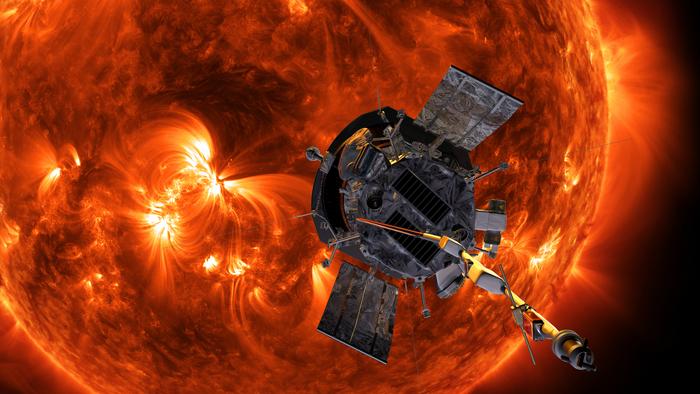1st mission to 'touch' the sun discovers a mysterious source of solar wind
NASA's Parker Solar Probe plunged into the sun's atmosphere to capture the granular details of how its solar wind is made.

A NASA spacecraft has skimmed through the sun's hellish atmosphere to discover a mysterious source of solar wind.
Away from the sun, the solar wind is a sloshing spray of energetic plasma. But get closer — as NASA's Parker Solar Probe recently did by diving within 13 million miles (21 million kilometers) of the sun's surface — and individual particle streams can be seen, and some of them are being steered by magnetic fields as they emerge from gigantic holes in the sun's surface.
The solar wind — a stream of charged protons, electrons and alpha particles — can be broken up into two broad categories of "fast" and "slow." The fast solar wind bursts out from around holes in the sun's atmosphere and can travel at peak speeds of 497 miles per second (800 kilometers per second) — twice the top speed of the slow wind.
Solar physicists have long wondered what makes one type of solar wind almost twice as fast as the other. Now the daredevil probe may have found the answer: The faster flows come from sudden whip-cracking bursts of energy released during the rapid realignment of magnetic fields. The researchers published their findings June 7 in the journal Nature.
Related: Puzzle of the sun's mysterious 'heartbeat' signals finally solved
"Winds carry lots of information from the sun to Earth, so understanding the mechanism behind the sun's wind is important for practical reasons on Earth," study co-author James Drake, a professor of physics at the University of Maryland, said in a statement. "That's going to affect our ability to understand how the sun releases energy and drives geomagnetic storms, which are a threat to our communication networks."
Because strong solar winds can cause geomagnetic storms that are powerful enough to send satellites tumbling to Earth or even cripple the internet, scientists are keen to figure out how they're made. Data from the Parker Solar Probe revealed that coronal holes — darker, cooler regions that open in the sun's outer atmosphere — are shaped like "showerheads" made up of mostly evenly spaced funnels of material up to 18,000 miles (29,000 km) wide. These funnels can either loop back into or beam completely out of the sun, depending on whether the magnetic-field lines that guide them are open or closed.
Sign up for the Live Science daily newsletter now
Get the world’s most fascinating discoveries delivered straight to your inbox.
"The photosphere [the lowest layer of the sun's atmosphere] is covered by convection cells, like in a boiling pot of water, and the larger scale convection flow is called supergranulation," lead author Stuart Bale, a professor of physics at the University of California, Berkeley, said in the statement. "Where these supergranulation cells meet and go downward, they drag the magnetic field in their path into this downward kind of funnel," he added. "The magnetic field becomes very intensified there because it's just jammed."
By detecting the speeds at which fast solar wind flows — sometimes recording readings of particles moving 10 to 100 times faster than the average for the solar wind — the researchers concluded that the only possible mechanism for launching fast solar wind is "magnetic switchbacks."
Switchbacks occur when closed magnetic-field loops close to the sun's surface link to open field lines stretching out of the sun, causing a whip-crack-like burst of energy as the field lines untangle to launch solar wind straight at Earth. When switchbacks are newly formed, their kinks are sharper, meaning that solar material is flung from them at much higher speeds than it is from older, smoother switchbacks, the researchers said.
"The big conclusion is that it's magnetic reconnection within these funnel structures that's providing the energy source of the fast solar wind," Bale said. "It doesn't just come from everywhere in a coronal hole. … It comes from these little bundles of magnetic energy that are associated with the convection flows."
To confirm their results, the researchers will continue to study data from the solar probe as it spirals ever closer to the sun, reaching a final destination of 4 million miles (6.4 million km) above its surface, where its instruments are expected to fry under the intense heat of the sun.

Ben Turner is a U.K. based staff writer at Live Science. He covers physics and astronomy, among other topics like tech and climate change. He graduated from University College London with a degree in particle physics before training as a journalist. When he's not writing, Ben enjoys reading literature, playing the guitar and embarrassing himself with chess.










